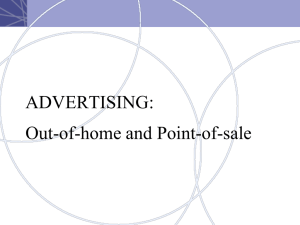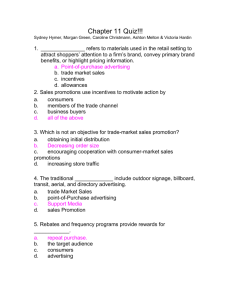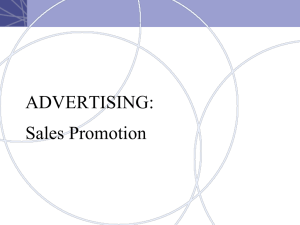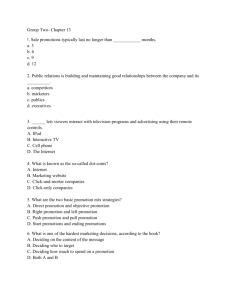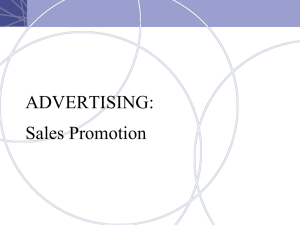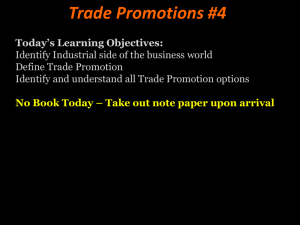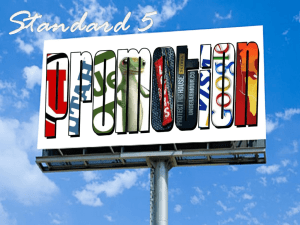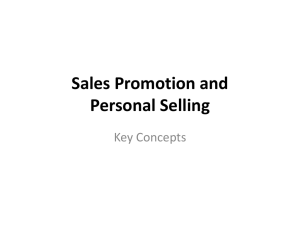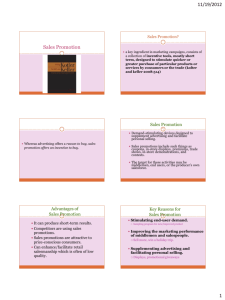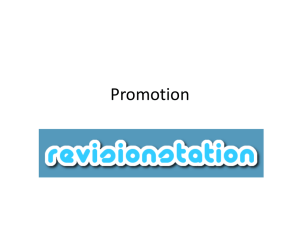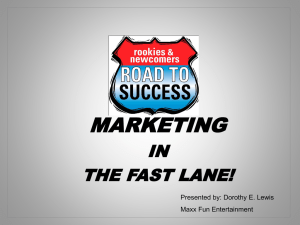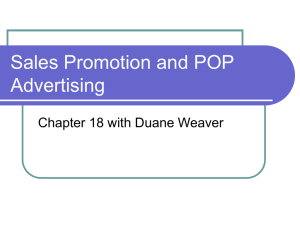Document
advertisement
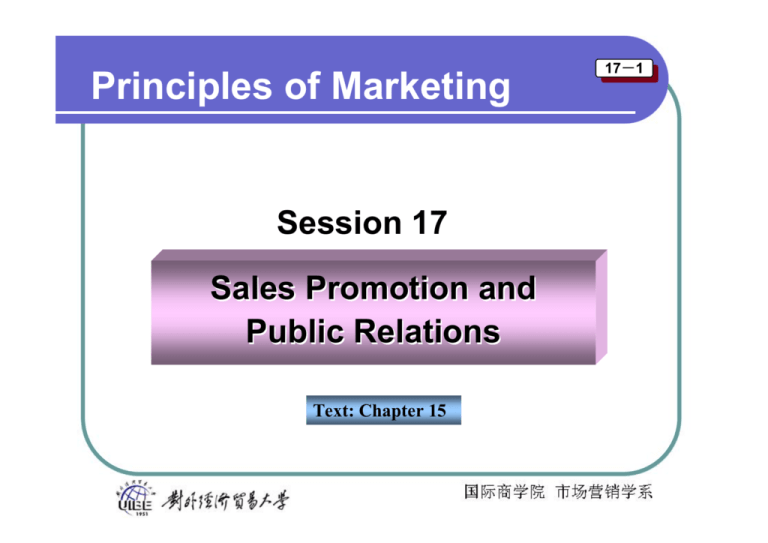
Principles of Marketing Session 17 Sales Promotion and Public Relations Text: Chapter 15 17-1 17-1 Outline I. Sales Promotion II. Public Relations 17-2 17-2 17-3 17-3 Sales Promotion Promotion I.I. Sales I-1 Sales Promotion Defined A mass communication technique that offers short-term incentives to encourage purchase or sales of a product or service. Offers reasons to buy now. -- Kotler & Armstrong 17-4 17-4 I-2 Sales Promotion Areas Business Business Promotion Promotion Sales Promotion Areas Trade Trade Promotion Promotion Consumer Consumer Promotion Promotion 17-5 17-5 I-3 Sales Promotion Tools 17-6 17-6 ¾ Contests and games of skill and chance ¾ ¾ ¾ ¾ ¾ ¾ ¾ ¾ Point-of-Purchase Patronage Rewards Advertising Specialties Premiums Cents-off deals or Price Packs Cash-back offers Redeemable coupons Samples 17-7 17-7 I-4 Developing Sales Promotion Programs Developing Implementing Evaluating 1-5 Objectives of Consumer Promotion ¾ Obtaining trial and repurchase ¾ Increasing consumption of an established brand ¾ Defending current customers ¾ Targeting a specific market ¾ 17-8 17-8 Enhancing advertising and marketing efforts I-6 Consumer Promotions ¾ ¾ ¾ ¾ ¾ ¾ ¾ ¾ Samples Coupons Premiums Contests/sweepstakes Refunds/rebates Bonus packs Price-offs Event sponsorship 17-9 17-9 I-7 Objectives of Trade Promotions z Obtain distribution for new products z Maintain trade support for established brands z Encourage retailers to display established brands z Build 17-10 17-10 retail inventories 1-8 Trade Promotion Tools z z z z z z Contests and dealer incentives Trade allowances Point-of-purchase displays Training programs Trade shows Cooperative advertising 17-11 17-11 1-9 The Sales Promotion Trap 17-12 17-12 Our Firm All Other Firms Cut back promotions Maintain promotions Cut back Higher profits for all promotions Market share goes to our firm Maintain Market share goes to Market share promotions all other firms stays constant; profits stay low 17-13 17-13 II. Public Public Relations Relations II. II-1 Public Relations Defined 17-14 17-14 PR involves building good relations with the company’s various publics by obtaining favorable publicity, building up a good corporate image, and handling or heading off unfavorable rumors, stories, and events. -- Kotler & Armstrong II-2 Value Added by Marketing Public Relations (MPR) ¾ ¾ ¾ ¾ ¾ ¾ ¾ 17-15 17-15 Building marketplace excitement before media advertising breaks Creating advertising news where there is no product news Introducing a product with little or no advertising Providing a value-added customer service Building brand-to-customer bonds Influencing the influentials Defending products at risk and giving consumers a reason to buy II-3 Advantages and Disadvantages of PR Advantages: ¾ credibility ¾ low cost ¾ less clutter ¾ lead generation ¾ ability to reach specific groups ¾ image building 17-16 17-16 Disadvantages: ¾ not completing the communication process ¾ redundancies the marketing effort with II-4 Public Relations Tools Tools of Public Relations ¾ ¾ ¾ ¾ ¾ ¾ ¾ Product Publicity Special Events Public Service Activities Materials Lobbying Corporate Communications 17-17 17-17 I-10 Breakdown of Spending on Event Sponsorship Where they spend $6 $5 6% $4 8% 9% $3 $2 $1 67% 10% Sports Cause Mktg. Music Arts Festivals 17-18 17-18 How much they spend (in billions) 5.00 4.70 4.20 3.70 3.30 2.80 2.50 2.10 1.75 $0 88 89 90 91 92 93 94 95 96 II-5 Public Relations Decisions Key Public Relations Decisions ¾ Objectives ¾ Messages ¾ Implementation ¾ Evaluation 17-19 17-19 II-6 Additional Means for Measuring PR’s Effectiveness ¾ Personal observation and reaction ¾ Matching objectives and results ¾ The team approach ¾ Management ¾ Public ¾ Audits by objectives opinion and surveys 17-20 17-20 Questions 17-21 17-21 1.What promotional tools have been taken in the following cases? 2.To bring high ROI for each, what efforts are usually required? ¾ 海尔加盟体育营销,聘请篮坛巨星作形象 代言人 ¾ 中石化成为2004-2006年F1中国站的独家 赛事赞助商
